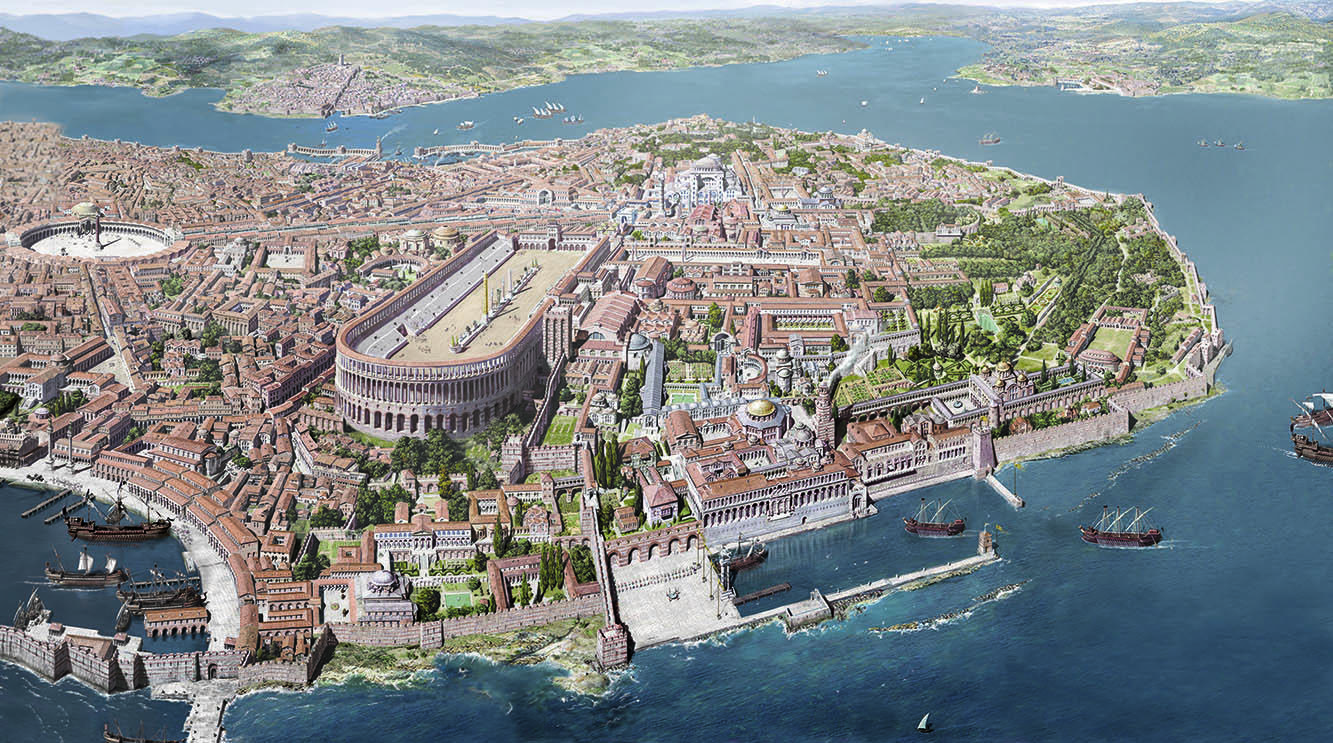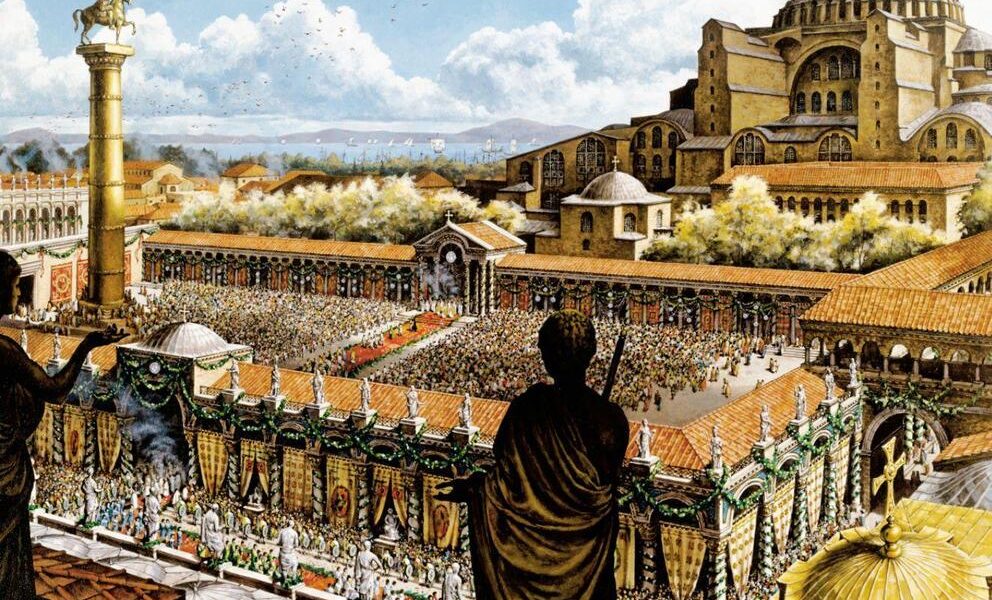On May 11, 330, Constantine I dedicated Byzantium (Constantinople; now Istanbul) as the new capital of the Eastern Roman Empire (Byzantine Empire), an act that helped transform it into a leading city of the world. Constantine led a grand procession through the streets of the new City to the base of a new Imperial Column at Constantinople’s centre to officially sanctify the city as the new centre of the Imperial Roman world.
Byzantium was colonised by Greeks from Megara in 657 BC and remained primarily Greek-speaking until its conquest by the Ottoman Empire in 1453 AD.
Constantine the Great, Roman Emperor from 306 to 337, was the first Christian Emperor and transitioned the empire from paganism to Christianity.
His mother, Helen, was a low-born Greek who, during a religious tour of Syria, Palestine and Jerusalem, discovered the True Cross.

The Emperor's decision to announce Byzantium, then renamed as New Rome, as the new capital city would see it continue the Roman Empire in its eastern provinces continue for another 1,000 years. Constantine was born around the year 272 AD in the city of Naissus.
The city was in the Roman province of Moesia, which is in the present-day country of Serbia. His father, Flavius Constantius, worked his way up in the Roman government until he became second in command as Caesar under Emperor Diocletian. Constantine grew up in the court of Emperor Diocletian.
He got an excellent education, learning to read and write in Latin and Greek. He also learned about Greek philosophy, mythology, and theatre.
Although he lived a privileged life, in many ways, Constantine was a hostage held by Diocletian to ensure his father remained loyal.
Early Career
Constantine fought in the Roman army for several years. He also witnessed Diocletian’s persecution and murder of the Christians. This had a lasting impact on him. When Diocletian became sick, he named a man called Galerius as his heir.
Galerius saw Constantine’s father as a rival, and Constantine feared for his life. There are stories that Galerius tried to have him killed in many ways, but Constantine survived each time.
Eventually, Constantine fled and joined his father in Gaul in the Western Roman Empire. He spent a year in Britain fighting alongside his father.
Becoming Emperor
When his father became ill, he named Constantine as Emperor, or Augustus, of the western portion of the Roman Empire. Constantine then ruled over Britain, Gaul, and Spain. He began to strengthen and build up much of the area.
He built roadways and cities. He moved his rule to Trier in Gaul and built up the city’s defences and public buildings. Constantine began to conquer neighbouring kings with his large army.
He expanded his portion of the Roman Empire. The people began to see him as a good leader. He also stopped the persecution of the Christians in his territory.
Civil War
When Galerius died in 311 AD, many powerful men wanted to take over the Roman Empire, and civil war broke out. A man named Maxentius declared himself Emperor. He lived in Rome and took control of Rome and Italy. Constantine and his army marched against Maxentius.
Constantine has a Dream.
As Constantine approached Rome in 312, he had reason to worry. His army was about half the size of Maxentius’ army. One night before Constantine faced Maxentius in battle he had a dream.
In the dream, he was told that he would win the battle if he fought under the sign of the Christian cross. The next day he had his soldiers paint crosses on their shields.
They dominated the battle, defeating Maxentius and taking control of Rome. Roman emperor ended the 300-year persecution of Christians because he “saw it in a dream.”
Becoming a Christian
After taking Rome, Constantine forged an alliance with Licinius in the east. Constantine would be Emperor of the West and Licinius in the East. In 313, they signed the Edict of Milan, which stated that Christians would no longer be persecuted in the Roman Empire. Constantine now considered himself a follower of the Christian faith.
Emperor of All of Rome
Seven years later, Licinius decided to renew the persecution of Christians. Constantine wouldn’t stand for this and marched against Licinius. After several battles, Constantine defeated Licinius and became ruler of a united Rome in 324.
Building in Rome
Constantine left his mark on Rome by building many new structures. He built a giant basilica in the forum. He rebuilt the Circus Maximus to hold even more people. Perhaps his most famous building in Rome is the Arch of Constantine. He had a giant arch built to commemorate his victory over Maxentius.
Constantinople
In 330 AD, Constantine established a new capital of the Roman Empire. He built it on the location of the ancient city of Byzantium. The city was named Constantinople after Emperor Constantine. Constantinople would later become the capital of the Eastern Roman Empire, also called the Byzantine Empire.
Death
Constantine ruled the Roman Empire until he died in 337. He was buried in the Church of the Holy Apostles in Constantinople.
Interesting Facts about Constantine
- His birth name was Flavius Valerius Constantinus.
- Constantinople was the most prominent and prosperous city of the Byzantine Empire during the Middle Ages. It became the capital of the Ottoman Empire in 1453. Today it is the city of Istanbul, the most populous city in Turkey.
- He sent his mother, Helena, to the Holy Land, where she found pieces of the cross that Jesus was crucified on. She was made Saint Helena as a result. Some accounts say Constantine saw the Greek letters Chi and Rho in his dream, not the Christian cross. Chi and Rho represented the spelling of Christ in Greek.
- He wasn’t baptised as a Christian until shortly before his death. In 326, he had his wife Fausta and his son Crispus put to death.
READ MORE: Greeks begin the long process of reviving destroyed Istanbul community after Turkish persecution.


